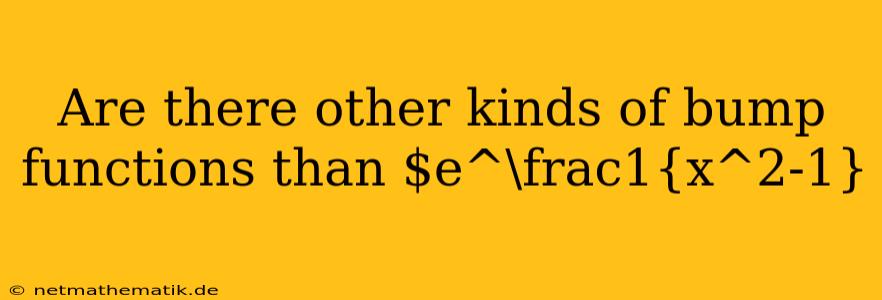The function $e^\frac{1}{x^2-1}$ is a classic example of a bump function, a smooth function with compact support. It is used in various areas of mathematics, particularly in analysis and topology. However, it is not the only function that exhibits these properties. This article delves into the nature of bump functions, exploring their characteristics, uses, and other examples beyond the common $e^\frac{1}{x^2-1}$.
Understanding Bump Functions
A bump function is a smooth function that is non-zero on a bounded interval and zero outside of that interval. The term "smooth" implies that the function has continuous derivatives of all orders, ensuring a continuous transition between the non-zero and zero regions. This property makes bump functions particularly useful for constructing smooth approximations of functions, often used in analysis and numerical methods.
Key Characteristics of Bump Functions:
- Compact Support: The support of a function is the set of points where the function is non-zero. A bump function has compact support, meaning its support is a closed and bounded interval, effectively "bumping" up and down within a defined range.
- Smoothness: Bump functions are infinitely differentiable. This ensures they are smooth and free from sharp corners or discontinuities.
- Non-Negativity: While not strictly necessary, many bump functions are constructed to be non-negative. This property simplifies their use in various applications.
The Ubiquitous $e^\frac{1}{x^2-1}$
The function $e^\frac{1}{x^2-1}$ is a popular choice for representing a bump function. It's defined on the interval (-1, 1) and smoothly transitions to zero outside this interval. Its smoothness arises from the fact that the function and all its derivatives approach zero as $x$ approaches -1 or 1.
Here's why this function is a good example:
- Simple and Elegant: Its formula is concise and easy to understand.
- Explicit Formula: It provides an explicit formula for a function that is smooth and has compact support.
- Easy to Manipulate: Its properties allow for straightforward modifications and extensions to create other bump functions.
Beyond the Standard: Other Kinds of Bump Functions
While $e^\frac{1}{x^2-1}$ is a common example, it's crucial to understand that it's not the only function exhibiting the properties of a bump function. Other functions can be constructed to achieve similar results.
Here are some examples:
- Using Trigonometric Functions: One approach involves modifying trigonometric functions to create a bump shape. For example, the function $f(x) = \cos^2(\pi x)$ for $0 \le x \le 1$ and $f(x) = 0$ otherwise, creates a bump function with compact support on [0, 1].
- Polynomial Approximations: By using polynomial approximations, it is possible to construct functions that approximate a bump function within a specific interval and smoothly decay to zero outside that interval.
- Piecewise Construction: One can define a function piecewise, using different expressions for different parts of the domain. By carefully choosing the functions and ensuring smooth transitions at the boundaries, one can create a bump function.
Applications of Bump Functions
The versatility of bump functions makes them widely used in various mathematical fields. Some of their key applications include:
- Approximation Theory: Bump functions are used to approximate other functions smoothly. This is particularly useful in numerical analysis for approximating complex functions or creating smooth interpolations.
- Construction of Partitions of Unity: They are crucial for constructing partitions of unity, which are essential tools in differential geometry and topology.
- Distribution Theory: Bump functions play a key role in the theory of distributions, which generalizes the concept of function and allows for working with functions that have singularities or are not continuously differentiable.
- Quantum Mechanics: In quantum mechanics, bump functions are used to represent wave packets, which describe the probability of finding a particle in a given region of space.
Conclusion
The $e^\frac{1}{x^2-1}$ function, while a well-known example of a bump function, is not the sole representative of this category. The existence of alternative bump functions highlights the versatility and richness of this concept in mathematics. Understanding various types of bump functions deepens our understanding of their fundamental properties and expands their applicability in diverse fields.
While the $e^\frac{1}{x^2-1}$ function is a classic and widely used example of a bump function, it is important to remember that this is just one possibility among many. The concept of bump functions extends beyond this specific example, offering a wealth of possibilities for creating smooth functions with compact support.
